Boyd - Field Notes - Tarte of Hippes (I and II)
Table of Contents
9/3/14 - Boyd - Hippes
Here are some sites that I referred to in establishing what Rosehips are and also where to find them:
http://nonabrooklyn.com/foraging-brooklyn-everythings-coming-up-rose-hips/http://wildandslow.com/wp-content/uploads/2011/03/WILD_ROSE_HIP_FINAL2.pdf
http://thedirtfarmer.hubpages.com/hub/Eat-Your-Rose-Hips-Theyre-Good-for-You
http://www.wikihow.com/Use-Rosehips-in-Cookery
http://www.backwoodshome.com/articles2/butler95.html
http://www.gardeningblog.net/how-to-grow/rose-hips/
9/3/14 - Boyd - Hippes
Posted on facebook to see if anyone knows where to find Rosehips. Also ordered some dried on Amazon.com in case they cannot be found in the flesh.Here is a link on how to reconstitute them: http://www.livestrong.com/article/556109-how-to-reconstitute-dried-fruit/
9/5/14 - Boyd - Hippes
Just got a text message from someone that they saw some rosehips growing in Queens. Heading out tomorrow to see if they are ripe and if they will be enough to use.9/6/14 - Boyd - Hippes
Just went to 46th Street in Queens to look for Rosehips. Saw two different varieties that sadly were not ripe :(9/7/14 - Boyd - Hippes
My uncle also messaged me that he can bring some rosehips back from his weekend trip, but they will not arrive until Tuesday morning, too late to cook with.9/8/14 - Boyd - Hippes
Think carefully about the ingredients. Are these analogous to modern ingredients? How are they similar or different? What about their purity? Were they exotic or common?
Rosehips:
My personal experience searching for them and speaking to other modern American people about them has taught me that you can find rosehips growing lots of places, particularly if you live in a rural location, so they are definitely also a modern ingredient. However they are not really a huge flavor in the modern American palate, and therefore are difficult to locate in a city; and also seasonal, with several sites (links above) mentioning that they are at their ripest after the first frost. Interestingly the only people writing about Rosehips seemed to be not academics but holistic medicine people, foragers, etc. The seasonal nature of the hips proved the greatest challenge to our locating edible ones - the ones we found when we went foraging simply were not ripe enough to be used. Others in other places appear to be ripe, but were impossible to acquire on our time frame. Dried rosehips most certainly would have been around in the 1580's as well, but our recipe clearly called for fresh ones so in that sense our ingredients were quite different than what this particular recipe required. This was a MAJOR OBSTACLE in our ability to create a faithful reconstruction - cooking with fresh rather than dried fruit is a totally different experience. Because we were reconstituting dried rosehips, the reconstitution process involved cooking them in hot water and we ended up with a kind of Rosehip goo (very much like a jelly or jam but not quite, which is why the term I've settled on is goo) that ended up making our Tarte quite like a jam tart, and I am not at all convinced that this is what the recipe intended. I suspect that if we had been able to source fresh rosehips, the tarte really would have been more like an apple tarte.
Sugar:
At the time, sugar would have been sold in blocks, but it still would have been refined and white. Would the block shape and grating off the block ourselves make a difference for this particular recipe? Since all our sugar was combined with liquids, I don't really think so. Perhaps the processing of the Domino's sugar we used might have some effect, but it's hard to tell since most organic companies today are focusing on brown and Demerera sugar production.
(http://www.oldandinteresting.com/sugar-nippers.aspx)
Ginger & Cinnamon:
Would these have been sold powdered or dried? Would the ginger have been fresh? Since ginger is not local to England and today is mostly produced in Asia and South America, we assumed it would have been imported and therefore not fresh. However we could not locate dried ginger in any other than powdered form. The cinnamon we grated ourselves using a nutmeg grater and cinnnamon stick. Incidentally, as is described in Jef's notes in further details, we also became convinced that nutmeg was called for in the recipe and sourced and grated our own nutmeg.
http://www.nhm.ac.uk/nature-online/life/plants-fungi/seeds-of-trade/page.dsml?section=regions®ion_ID=6&page=spread&ref=spices [accessed 8 Sep 14]
Flour:
Jef bought a specialty stone milled flour from Eataly from "Wild Hive Farm," a micromill where, according to their packaging, they "stone grind locally grown and organic grains in small batches". We figured that was probably the closest we could get, lacking Elizabethan-style grinding tools of our own.
Eggs:
We used Heirloom eggs from free-range chickens, hormone and anti-biotic free. But we bought them in a store. Definitely not as fresh as the kind an Elizabethan would be working with. Neither of us had time to go to a Farmer's Market for farm fresh eggs.
Butter:
Did Elizabethans salt their butter? Unclear. We used salted butter because it was impossible to buy a small quantity of unsalted butter and we were running out of funds.
Water:
The "paste" recipe called for cold water. Modern tart dough usually uses even ice water. But how cold could Elizabethans even make their water? Certainly not ice-y cold. Fresh from the well? Probably that was pretty cold. How could we truly know without having access to an Elizabethan-style water well, which we don't? Even then, who is to say water is running beneath the well at the same temperature as it was back then? We went with the coldest water that runs from my tap.
What about your heating apparatus and cookware? Could the authenticity of your pots, pans, ladles, ovens, and heating elements change the outcome of a recipe?
Absolutely they could, but we had to work within the limits of what was available for us at the time of the experiment. In a Manhattan apartment with no access to outdoor space, it would not be possible to safely reconstruct and Elizabethan wood or coal oven, so an electric one had to do. We researched cooking implements in the images of the Scappi book, and saw a tart pan that was clearly metal (see images captured in our powerpoint), and looked like thin metal, so we used a thin metal pie pan. We made the call that the stirring implements probably wouldn't have too much of an effect on the overall outcome, and used everyday modern kitchen implements. Another piece of cookware it was impossible to reproduce on our budget and timeframe was a "gellipot close", or closed gallipot (according to the OED "A small earthen glazed pot, esp. one used by apothecaries for ointments and medicines." - http://www.oed.com/view/Entry/76321?redirectedFrom=gallipot#eid)
What tacit information has been left out of your recipe? What did you do in your reconstruction that was not discussed by the original author?
All metrics were left out of our recipe, including amounts, times, etc. Whether or not there was dough, and how to make it, and what kind of container it might be cooked in, were left out of the recipe, so we picked a roughly contemporaneous dough recipe (from Delightes for Ladies, 1603 -
http://www.celtnet.org.uk/recipes/delights-ladies-1.php#24) and made the tart two ways - one in a metal tart tin, and free-hand, with no tin at all. It was also left out whether the dish was meant to be cooked at all. However, other recipes in the same book used explicit measurements. Therefore, overall we made the assumption that if the author left a measurement out, it was because he assumed the amount or the time was obvious or common-sense. We seasoned to our own taste, for example, and cooked the tart until the crust was browned but not burnt, which seemed the "common-sense" amount of time to cook a tart. The question, however, remains, as to whether my common sense would agree with an Elizabethan's common sense or be so different as to be detrimental to effective carrying out of the recipe instruction.
Who wrote your recipe? Why did they write it down and/or publish it?
Our recipe was written by Thomas Dawson in his book, "The good husvvifes ievvell VVherein is to be found most excellent and rare deuises for conceits in cookerie, found out by the practise of Thomas Dawson. Whereunto is adioyned sundry approued reseits for many soueraine oyles, and the way to distill many precious waters, with diuers approued medicines for many diseases. Also certaine approued points of husbandry, very necessarie for all husbandmen to know." The explicit purpose of the manual in which it was found is contained in the title: to explain principles of cooking and housekeeping to housewives. One might also assume, based on the fact that certain ingredients (like the spices) can't have been inexpensive, that the recipe book is aimed at Elizabethan England's rising middle class - the target audience being a household where the mistress is still doing the cooking herself, but can also afford to purchase special ingredients.
Making the recipe:
As I was up to my elbows in flour for most of the cooking part, I will be referring to Jef's notes regarding the specific actions we took during the baking process.
Some observations that I would like to add: the level of hubris involved in the Nutmeg Debacle (which Jef describes in detail) - I was so excited, reading "Mace" in another early modern recipe, to know that it was Nutmeg (and probably also because my favorite recipe for ginger cookies calls for cinnamon, ginger and nutmeg so my modern sensibilities expect them to go together) that I somehow became absolutely convinced that "Mace" was called for in this recipe. As Jef mentions, I then handed him the grinder and a nutmeg and he ground a sizable quantity of it and we even went so far as adding it to the bowl before we realized that it was not called for in the recipe. Really underscored for me the necessity for "self-policing" or reflexivity, as we called it in our outline, to insure t
hat not just our modern sensibilities, but also our pure human error, doesn't contaminate the authenticity of the reproduction.
As the main "baker" on this project, I do have to say that it was VERY difficult to remain "scientific" about what I was doing. The temptation to add a dash and a pinch or just "enough" of something based on my own personal instinct, as opposed to a 1/4 tsp or 3/4 c. or some other measurable quantity, was extremely great. Jef really had to "keep me honest" in terms of reminding me that we were trying to be scientific and had to create a recipe that it is possible to reproduce. That really sheds light for me on why the original recipe is so vague. Of course it doesn't specify the amount of cinnamon or sugar or ginger - that is totally a matter of personal taste. If asked my dad how he makes his delicious apple pie, he would definitely tell me something like "add sugar and cinnamon until it tastes good." - I don't think that's a particularly an "Elizabethan" or "Early Modern" thing - I think it's thing done by people who know what they're talking about to other people who also know what they're talking about. The trouble is that having never made, eaten or even seen a Tarte of Hippes before, there is no way for me to actually "know what they're talking about". This also partly has to do with letting the product get in the way of the reconstruction - when baking, instinct dictates to try and make the food taste good. But as discussed in class that's not necessarily the point of the exercise.
The "Gellipot" - I think it's very important to note that I believe this recipe actually contains TWO recipes. The first part refers to the making of a Rosehip Tart, and the second part, beginning with "So..." denotes what to do with the leftover filling in order to preserve it for future use. Really the recipe is for a rosehip tart, and a kind of rosehip preserves. Or at least that is the only way I can find to make sense of the latter half of the recipe.
Our new recipe: Rosehip Tart, Two Ways
Equipment:Bowl
Measuring cup and spoons
Pie/Tart tin
Rolling Pin
Countertop
Mixing Spoon
Butter Knife
Cookie Sheet
Oven
Ingredients:
4 cups of flour (plus extra for the rolling process)
Three egg whites
Two egg yolks
1 cup water
1.5 sticks (3/4 c.) cold butter
1 lb dried rosehips (plus water for reconstituting them)
1 and 1/3 c. granulated white sugar
6 tsp. ground cinnamon
6 tsp. ground ginger
For the dough:
In a large bowl, mix flour with eggs, adding water as necessary until it has a gummy, tacky consistency (like biscuit dough).
Lightly flour your rolling surface and place dough on floured area, covering dough and rolling pin with extra flour so that it does not stick to the dough.
Roll dough until it's between 1/8 inch and 1/4 inch thick.
Using a knife, cut small pieces of butter (about the size of a shelled hazelnut) and drop them evenly across the surface of the dough.
Fold up the dough, encompassing the butter pieces inside the folds, and re-flour and re-roll the dough.
Repeat the above two steps a total of 10 times.
Divide the dough in half. Roll one 1/2 of the dough out again, thinner than previously, and drape it over your pie tin/tart tin until it is covered. Trim e
xcess from sides and reserve for future use.
Add filling and bake, open-faced, at 350 degrees for 35-40 minutes.
Roll out the second 1/2 of the dough, more thick than the portion you used for the tart pan, and place on a cookie sheet.
Spoon filling onto the dough but leave enough of a border around the outside that you will be able to just cover the top of the filling.
Fold the sides of the dough over the filling so that the filling is completely enclosed like a Beef Wellington.
Bake at 350 degrees for 50 minutes.
For the filling:
Take dried rosehips and pour boiling water over them in a pot on the stove - just enough to cover.
Turn the burner on and heat until boiling.
Stir frequently until water begins to be absorbed by the hips.
Add more water.
Continue heating at a low boil and adding more water regularly until the hips begin to soften and turn into an edible goop.
Add sugar and spices and mix into the hip goop. Scoop filling into crust as described in either method above.
Additional notes regarding the execution of the project:
-More time would have been a great help, especially given the difficulty of acquiring the main ingredient in a fresh state. It literally had to either be foraged wild (which we attempted), and likely from a place that is not New York City. This would absolutely have been possible (and fun!), but not within the time constraints of this project.-I am personally somewhat unclear about the nature of the field notes we should be taking, the level of reliability/scholarly clout which is required in the sources which we reference (e.g., is someone's internet blog about foraging for rosehips in Brooklyn an acceptable source?, etc.). But perhaps this is something I missed on the first day of class?
-Is it acceptable to refer to your partner's notes for part of the experiment? Obviously with such hands on (and sometimes time sensitive) work, there are times when one person will be up their elbows in something (in this case, flour), making note-taking by both parties at the same time a challenge.
-I have some concerns about typing notes directly into the wiki. When I copy and paste, an annoying glitch occurs where it scrolls to the bottom of the page and I totally lose my place. Additionally I am not sure whether it autosaves and I'm nervous about losing my work. If I work in the wiki for more than a few minutes without clicking a different page within the wiki, my computer automatically logs me out and I'm worried some work could get lost.
Boyd - Hippes - 9/9/14
Analysis of project based on in-class template:-Purpose: knowing your goal: why do this particular reconstruction? For what level of authenticity are we striving?
Our goal is to learn about historical recipe reconstruction by attempting to make a "Tarte of Hippes". We are striving to be as authentic as possible within the serious time and financial constraints imposed on us.
-Context: historical context: reading widely (a zillion recipes for glue); author: what else did he/she write down; immediate context: look at groups of recipes (“one way, another way, another way…” format); recipe families.
There are several other tart recipes in "The Good Housewife's Jewell" - we also had to research around a bit to find a recipe for "paste" (dough) that would be manageable for us and ended up settling on one from "Delightes for Ladies", 1603, because the instructions were very clear, the perio
d was fairly contemporaneous with our 1587 original recipe, and it seemed feasible to execute.
-Recipe: examine recipe, actions to be taken, what omitted and described?
Omitted: no recipe for tarte dough, no information about metrics whatsoever.
Described: cutting and cleaning the hips - must be fresh; "gellipot close" - description of something else to do after the tarte has been made - why?
-Instructions: what do they even mean? (“indifferently heated”, e.g.); look up words that may have changed their meanings (in the OED or Chamber’s Cyclopaedia)
Words we looked up: "Hippes" (rosehips), "Tarte" (to find out whether the Elizabethans had the same definition we do, and to establish whether to them, a tarte was openfaced or closed), "preserve" (does the use of this word indicate that we are now making preserves? I think it does), "gellipot close" (such a word doesn't seem to exist but it does make sense that this could be a reference to a gallipot, see above).
-Ingredients: their source, how refined, and in what form to be used? Safety vs. authenticity? (Raw milk, hand-ground flour, etc.)
See above.
-Metrics/Units of Measure: issues of scale (24 eggs, lbs of flour); how much was an Early Modern lb? were these measurements standardized? time (is it important – not for glue, e.g.); “enough” – how to be consistent when you don’t have a preconceived notion of what “enough” is?
See "Making the recipe", above.
-Equipment/Technologies: culinary technologies, kinds of heat etc. (wood, charcoal, peat?) – how to reproduce as much as possible? How do we deal with impurities – do we strive to filter them out? Under what limitations were they working?
See above. Also Jef recorded some of our observations regarding our surprise, upon examining the images in the Galli text, at just how sophisticated some of their implements were. We had been assuming something a lot more simple. No metal pans, e.g., when in fact it appears they did have such.
-Reflexivity: filtering out our contemporary understandings and expectations; annotating where compromises were made; not letting the product get in the way of the process.
As is mentioned above, this was a major challenge for me personally. I felt their was a great tension between the recipe's lack of specific me
trics, and my contemporary expectations. What instinct can I rely on to figure out how much spices to use - whether to use a floured surface when rolling out the dough when none is called for, etc., other than my own? But my own understanding of baking is a undeniably a contemporary one. This creates a kind of paradox. The recipe was clearly written for someone who already has an understanding of certain tastes and concepts. I have my own understanding of certain tastes and concepts of baking - but is it appropriate to rely on my understanding, given the fact that I'm 400+ years removed from the person who wrote the recipe? How much has changed? We literally cannot know.
Boyd - Field Notes - Tarte of Hippes (III)
Boyd - Hippes - 9/11/14
So my uncle brought me a ton of Rosehips all the way from Rhode Island but they didn't get here until yesterday.
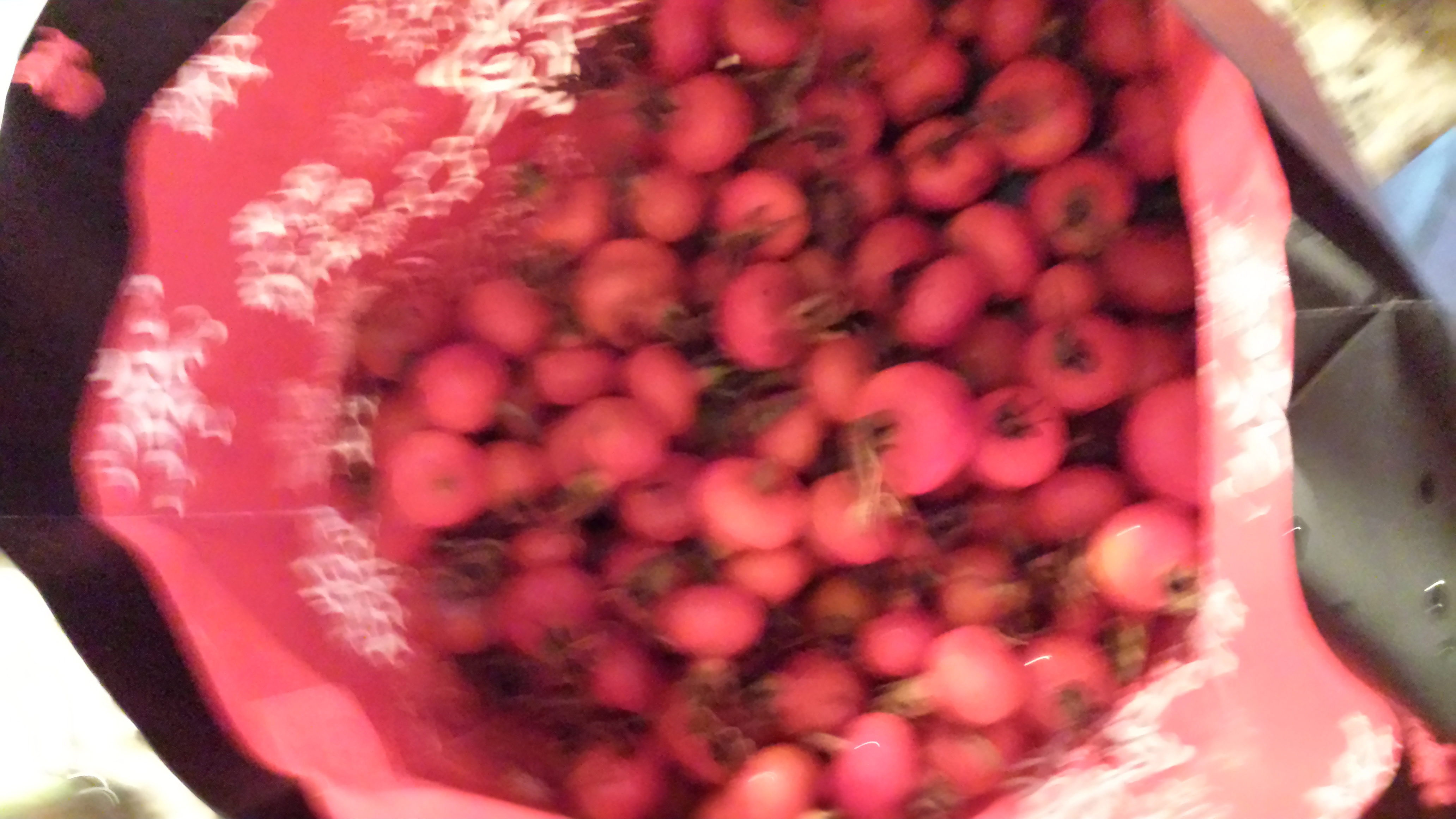
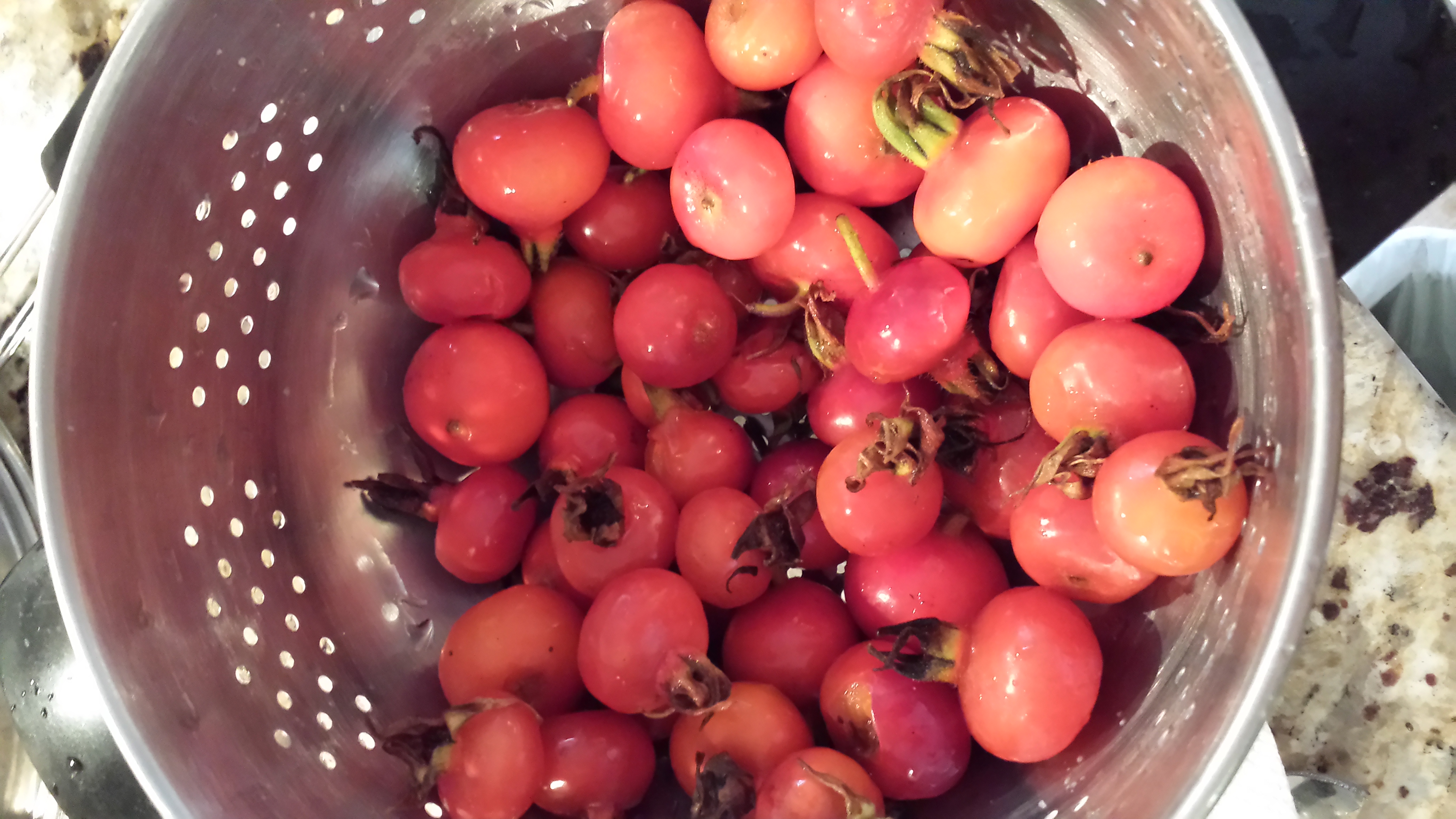
I still had some dough left over from the first batch we had made, so I just thought, what the heck. Let's see how different this thing turns out when you're using the real deal.
I washed and de-seeded 50 rosehips...


...which turned out to be a bit of a pain - those little guys are FULL of seeds, and if they are too ripe, the whole thing will literally just squish together in your hand as you try to scoop them out, seeds included. But supposedly they're not truly ripe until they are soft to the touch, so a delicate balance had to be struck - they really needed to be in a pretty perfect state of ripeness to be useful for this tart. If they were small, I left them in halves, but if they were larger, I cut them in quarters. This also assisted in the de-seeding process, as it was easier to remove the seeds sometimes when they were in smaller pieces, because they were easier to reach.
50 still would not have been enough to fill a tarte pan like the one we used for our first try last time - I probably would have needed to do around 75-100, but since I had decided to make this one freehand, I thought what I had would be enough. I used the same proportion of sugar (2/3 c.) and ginger (3tsp) as last time, but I had thought the last batch too cinnamon-y, so I only used 1 tsp. cinnamon.
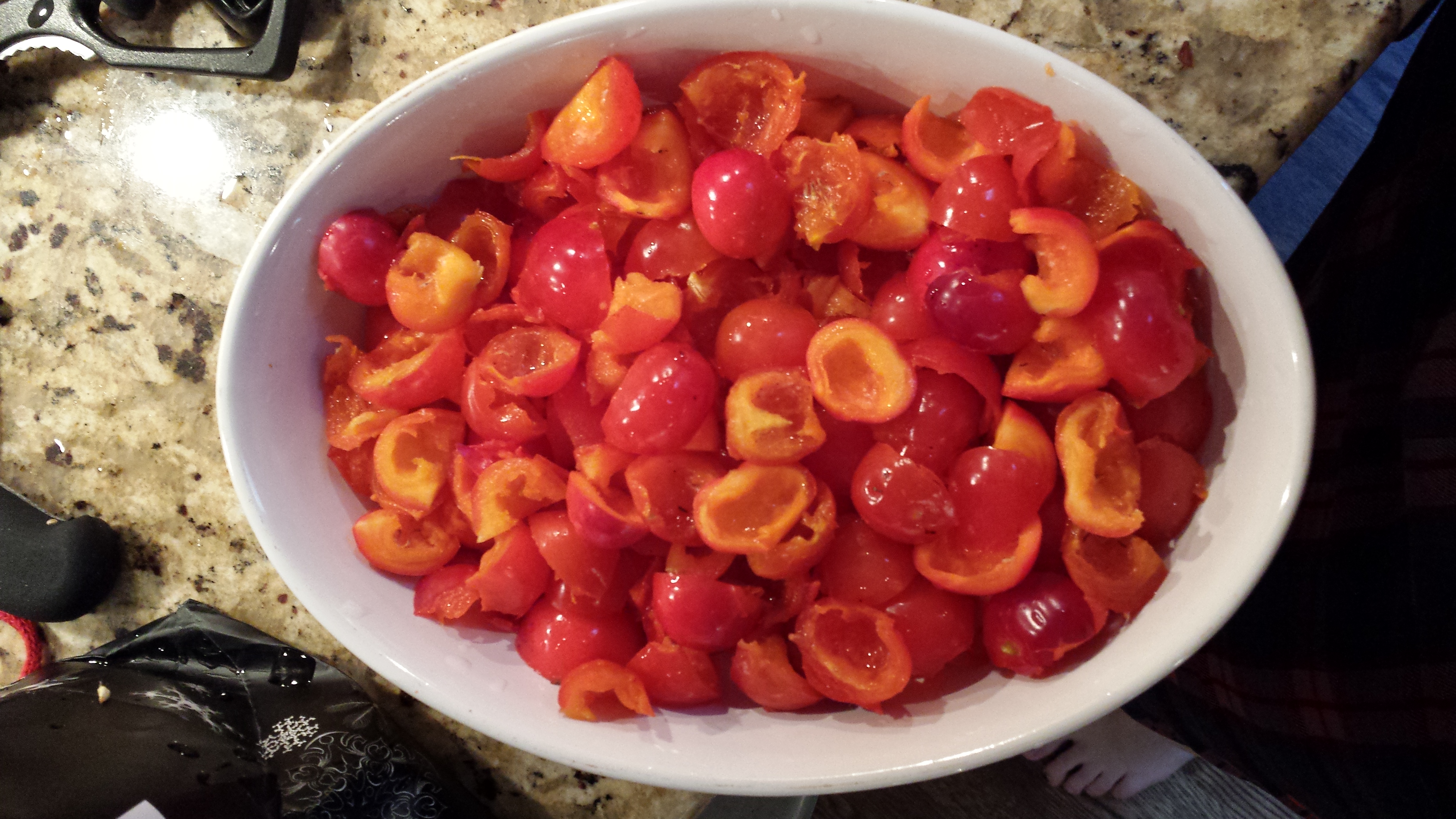
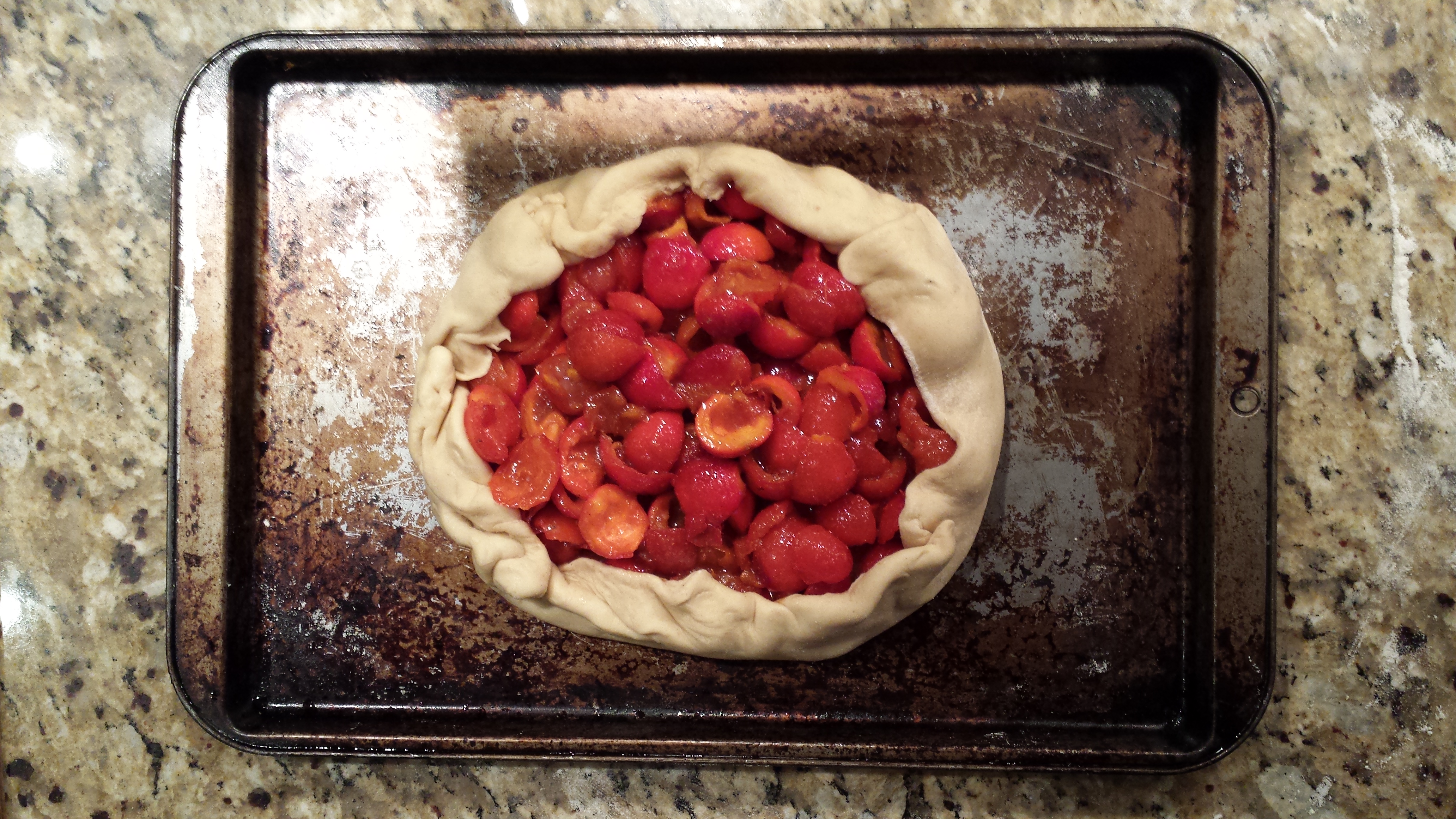
I'm interested to see how the sweetness turns out, given that it really seemed like a lot of sugar, and also whether it is too spicey, as it smelled very strongly of ginger. I wonder how the taste of the fresh fruit will change the otherwise (mostly) the same ratios of ingredients.
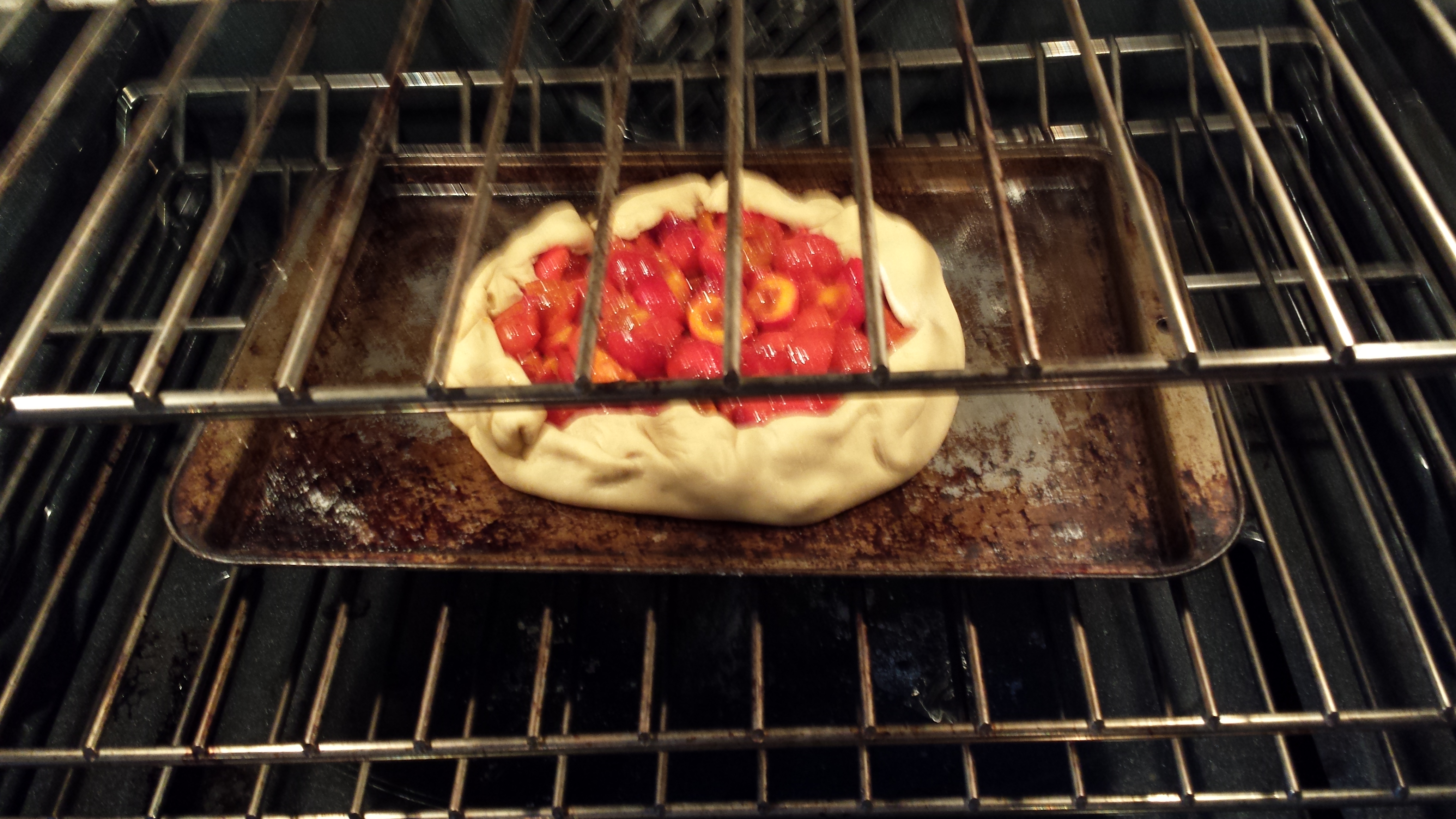

OK, so as the tarte cooked up, the most wonderful smell arose from the oven and I peeked in to see the liquid from the filling leaking over the side of the tarte and carmelizing in the pan. This dish looks immeasurably more appealing than the last tartes we made, and I am very excited to try it out. I cooked it for 33 minutes, until the crust was hard when I tapped it gently with my nail, and just beginning to brown.
Final Fresh Rosehip Tarte Recipe:
Follow dough making instructions as above.
-De-seed 50-100 ripe rosehips depending on the size of the tart you intend to make, and cut them into 1/2s or 1/4s, depending on the size of the individual fruit. You are going for pleasant bite-sized pieces. Do make sure the rose hips are *just* ripe. This is important because if they are too ripe, they will just smush up in your hand as you try to remove the seeds and become pretty unusable for tart purposes, but if they are not ripe enough, they will be too hard and not have their full flavor. Budget extra time for this, as the process of deseeding them is time consuming.
-Mix them with ⅔ c. sugar, 3 tsps ginger, and 1 tsp. cinnamon, or vary the spices and sugar proportions to taste. You may wish to add more if you use more hips. I used the specified proportions for 50 rosehips, but I did think the tart was very sweet.
-Roll out your tart dough about ⅛ inch thick making sure to flour your surface well, to make the transfer of the dough easy.
-Transfer dough to a baking sheet, still flat.
-Pour rosehip/sugar/spice mixture onto the middle of the dough.
-Fold up the sides of the dough around the filling in whatever shape pleases you. I did a circle, but I think you could just as easily do a rectangle or a square. It would also be possible to make the tart in a tart pan, but I like the rustic, hand-hewn look of shaping the tart yourself, and I think it accords with the Elizabethan practice of making "coffins" of dough for individual-sized tarts, which really sounds to me like something that was shaped by hand. Just make sure that the sides go high enough that when the filling bubbles as it cooks, there are no low areas of the crust where it can run over the side of the tart and spill out onto the baking sheet.
-Bake at 350 degrees for 30-35 minute, until the crust is hard when tapped, and just beginning to brown.